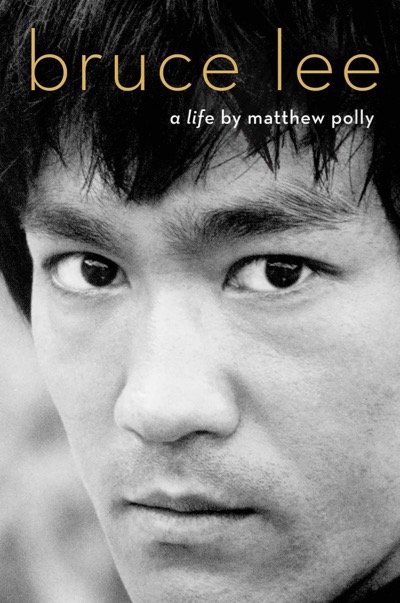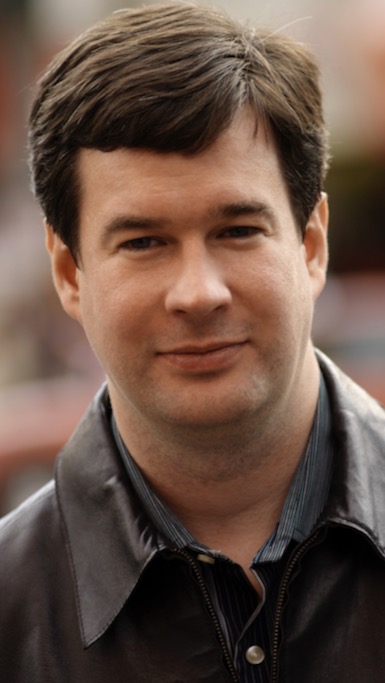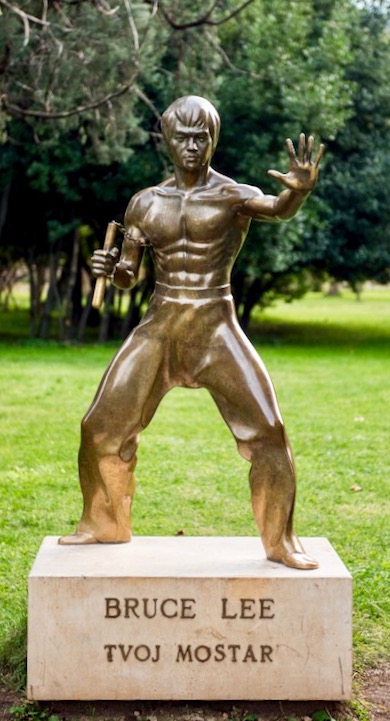By DAVID CRUMM
Editor of ReadTheSpirit magazine
When you think of Bruce Lee—you may simply dismiss his legacy as fuel for violent movies.
If you do, then you’re missing Bruce Lee’s iconic status around the world as a symbol of crossing cultural and racial boundaries in pursuit of peace. You may be asking: What!?! Bruce Lee—the king of kung fu movies—is also a symbol of transformational peacemaking?
In fact, journalist and best-selling author Matthew Polly makes a fascinating case for exactly that status for this Eurasian innovator in martial arts, spirituality and media. It’s all in Polly’s new in-depth biography, Bruce Lee: A Life.
Are you questioning the claims you are reading here? Well, consider one recent example from Polly’s book. Did you know that as recently as 2005 in Mostar—in the deeply divided land of Bosnia Herzegovina—the community wanted to install a monument to cross-cultural peacemaking in the city park. Community leaders skipped over such heroic figures as the Pope and Ghandhi—as too divisive. Instead, they settled on a statue of Bruce Lee.
The public-art project was spearheaded by Mostar Urban Movement, a youth group headed by Nino Raspudić and Veselin Gatalo, who described the statue as “an attempt to question symbols, old and new, by mixing up high grandeur with mass culture and kung fu.” They regard Bruce Lee as a symbol of the fight against ethnic divisions and the effort to bridge cultures. “One thing we all have in common is Bruce Lee,” they said.
Stunning, but true. There’s a photo of that statue, below.
One problem with wrapping our minds around this aspect of Lee’s legacy, Polly points out, is that he is most famous today in what Americans think of as emerging or Third World countries. In fact, Polly argues persuasively that Lee is one of the 20th century’s most influential figures. In the book, Polly writes:
Bruce was not simply an entertainer; he was an evangelist. Through the popular medium of film, he single-handedly introduced more people to Asian culture than any other person in history. Because of Bruce, millions of westerners took up the martial arts. … Many devoted martial arts students went on to explore the Chinese philosophical underpinnings of their styles. Taoist terms like “yin” and “yang” entered the lexicon.
And that’s why Polly took on the enormous challenge of writing the first fully researched biography of Lee—a book recently recommended for summer reading by The New York Times Book Review. (The Times calls this book “the first noteworthy treatment of its subject and a definitive one at that.” Today, Lee seems like “a visitor from the future,” the Times says.)
Here is how Polly explains his decision to tackle this larger-than-life story. He writes:
Bruce consistently ranks in the top 15 of Forbes magazine’s list of top-earning dead celebrities, along with such idols as Elvis Presley, Marilyn Monroe and Steve McQueen. All of those iconic figures have proper biographies, except for Lee. Hardly a year goes by that a book isn’t published about Marilyn Monroe. There are half a dozen biographies of Steve McQueen.
It offended me. Bruce Lee was the first Chinese American male actor to ever star in a Hollywood movie. He inspired millions of people to take up the martial arts. He deserved an authoritative biography. I set out to write it.
‘WHAT WAS DRIVING HIM’
So what are the big headlines in this 650-page, $35 hardback?
When I interviewed Polly about his years of research and writing, I told him: “I began studying film and journalism at the University of Michigan in 1973, the year of Bruce’s big American debut in Enter the Dragon—and then he died that same year! I still remember all the mystery and controversy that surrounded his life and death. Now, 45 years later, I feel like your biography introduces me to the real Bruce Lee without all that lurid hype back in the mid 1970s. I feel like I’m finally getting to know this media innovator who I barely understood before.”
“That’s what I hoped this book would feel like to fans who have followed Bruce through all these years,” Polly said. “And I’m pleased that some of the early readers are responding just like you are. I’m hearing: ‘Now, I finally understand where he was coming from, what was driving him—and everything he accomplished.’ What Bruce achieved ultimately was amazing and it continues to this day. What’s even more impressive is that what he accomplished looked neigh on impossible at the start. But, he was willing to pay any price to achieve it. Ultimately, because of the way he drove himself, the price was his life.”
BUSTING BRUCE LEE MYTHS
In the course of this book, Polly tells lots of fascinating—sometimes suspenseful and sometimes downright funny—true stories about Bruce Lee. As he takes us through his life, Polly also busts a whole series of myths.
THE MYTH OF THE CHINESE STREET KID—Depending on where you got your ideas about Bruce Lee, perhaps from TV or other movies about kung fu, you may think of him as springing from the mean streets of Hong Kong. In fact, his family came from a wealthy and well-connected background that included a Jewish patriarch. (See the video below for more details on that.) Lee was, in fact, born in the U.S., then went back to Hong Kong where his parents cast him as a child actor in a whole series of movies. Eventually, Bruce became a competitive ballroom dancer and won prizes for his specialty: the cha cha!
THE MYTH OF IP MAN—These days, there may be more feature films on the nearly legendary kung fu innovator Ip Man (1893-1972). The myth is that Bruce Lee was hand picked by Ip Man at a very early age—and Lee eventually brought all of Ip Man’s legacy out of China and into the rest of the world. In fact, Bruce was a student for a while in Ip Man’s school, but the master gave Bruce little personal attention. As Bruce emerged as an Asian movie star, Ip Man was happy to celebrate Bruce’s return visits and to describe him as a star pupil. Fundamentally, however, Bruce did not carry on Ip Man’s exact system. Bruce’s genius—and his daring innovation—lay in his belief that traditional kung fu systems should continually evolve.
THE MYTH OF ‘KUNG FU’—As Lee and his family and fans retold the story of the hit TV series, Kung Fu (1972-1975), a myth arose that TV producers stole Bruce Lee’s idea for this TV series and then rejected him as a star. Because of anti-Asian bias, they cast Bruce Carradine to play the starring role. In fact, Polly documents that Lee’s early script was something similar, but distinctively different. In fact, he did not write Kung Fu. That was the work of other writers. Then, Lee actually was given an audition for the TV series, but he performed poorly. Lee’s original script was for a series that came to be called The Warrior, which finally is being developed by Cinemax for release within the next year.
THE MYTHS OF HIS DEATH—A host of wild myths surround Bruce Lee’s death, largely fueled by undue secrecy among Lee’s friends and colleagues. In the midst of shock at his untimely death, they were trying to protect his reputation. Among other things, they were trying to conceal Lee’s extra-marital love life that complicated his death. Polly researched all of the available evidence and concludes that Lee’s death was triggered largely by heat exhaustion. His sudden death was, indeed, a tragedy. But, it was not a dark mystery in which killers somehow escaped justice.
BREAKING BARRIERS
One truth about Bruce Lee that is consistently retold in all the existing media about Bruce Lee is that he believed in ignoring racial and cultural barriers. His first student, when he opened his American school, was African-American.
“And, at that time, no Chinese instructors were teaching African Americans. It caused some real friction because Bruce did that. But, he would not make racial or cultural distinctions. As a result, he wound up having the most racially diverse student body of any major teacher in America because he simply did not care about race,” Polly said in our interview.
For readers fascinated by connections in world religion, the heart of Polly’s book describes Lee’s restless personal quest for spiritual answers. A self-proclaimed atheist, Lee nevertheless believed that there were universal spiritual truths that each individual was called to explore. He read voraciously and collected a library of thousands of books, including works on Eastern approaches to spirituality. Lee was especially influenced by the life and work of Jiddu Kirshnamurti (1895-1986), who once was regarded as an emerging “world teacher”—then later rejected that claim and urged people to develop their own spiritual pathways.
That fit perfectly with Lee’s philosophy of life—and his belief that he was called to mix Chinese kung fu with American systems of self defense. We must each determine our own truths, Bruce Lee believed.
In our interview, Polly said, “When he first came back to America, he was very much in the Daoist tradition and then he added a little Zen Buddhism. His big breakthrough was discovering Krishnamurti. This was very much in keeping with the ’60s anti-establishment counterculture. We might think about the way American student protesters were questioning the Vietnam War and the values they had inherited at that time. Bruce was questioning Chinese tradition and kung fu traditions and, in the end, he put the individual at the center of his universe. He taught that each person had to find their own truth. We can borrow from tradition, but ultimately we have to develop our own spiritual path. That was the core of Bruce’s philosophy at the time of his death.”
THE BEST BRUCE LEE MOVIES
No story about Bruce Lee would be complete without recommending a list of “the best Bruce Lee movies.” This is important, in part, because there now are exploitation films that appear to be authentic Bruce Lee movies—but are actually knock offs.
And here’s a special note to Bruce Lee TV fans: DC Comics has revived interest in Bruce Lee’s co-starring role in the TV series The Green Hornet (1966-67) by featuring the characters from the TV show in a series of comic books co-starring Batman and Robin. However, no producers have properly restored the original TV series for streaming or for a quality DVD or Blu-ray release. So, if you were once a fan of that TV series and would like to see it, again—you’re pretty much out of luck at this point.
Here are Matthew Polly’s recommendations of Bruce Lee’s feature films that are widely available:
“Enter the Dragon (1973) is the one movie that anyone interested in Bruce Lee should see first,” Polly said. “Then, after that, I would recommend Way of the Dragon (1972), because he wrote, directed and starred in that movie, so he had total control of that project. You get a real sense of him as a filmmaker.
“If you want to dig deeper, then find a copy of The Orphan (1960), which Bruce made in Hong Kong,” Polly said. “It was Hong Kong’s idea of a Rebel-without-a-Cause kind of movie and Bruce was doing a James Dean kind of character. I think that was Bruce’s best acting performance.”
‘Like … Greek Mythology’
Lee’s iconic image as a bare-chested kung fu fighter still is widely known across Asia, eastern Europe and Africa, Polly said. “I don’t think there’s a single place on earth where I could go and have people look at a photo of him and not recognize him. This may be hard for Americans to appreciate, because we think first of actors like John Wayne as universally popular. But, John Wayne isn’t as well known around the world as Bruce Lee continues to be. Bruce is known like Michael Jackson everywhere you go.
“I think Bruce appeals to people today like our modern version of Greek mythology. He represents the spirit of the warrior seeking justice. He’s an underdog, trying to do the impossible. As a fan myself, I felt it was essential that I honor his legacy by writing this biography. Someone needed to carefully dig out all the truth about him and then write that truth for the world to see.”
VIDEOS ABOUT BRUCE LEE
In this first 2-minute video clip, produced for the release of Polly’s book, the filmmakers have some fun as they explain Bruce Lee’s complicated family tree. If you don’t see a video screen, below, then you also can see the video at YouTube.
In this even-shorter video, you’ll get to see Matthew Polly talking about the “kung fu craze” that followed the debut of Enter the Dragon. If you don’t see a video screen, below, then you also can see the video at YouTube.
Care to read more?
GET THE BOOK—You can order Bruce Lee: A Life from Amazon, or Barnes & Noble.
VISIT MATTHEW—Learn more about his ongoing work at his website www.MattPolly.com.
VISIT OUR BOOKSTORES—You’ll find lots of books that explore the challenges of cross-cultural friendship in our own ReadTheSpiritBookstore and our new Front Edge Publishing Bookstore.




